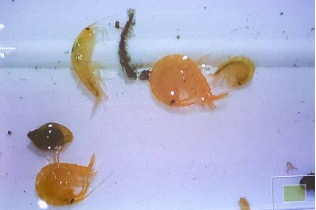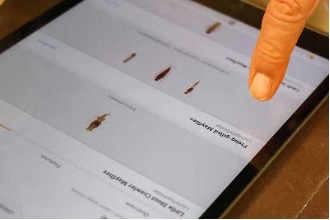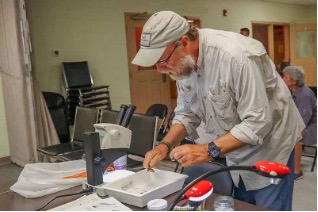Apr 25, 2025
TVA and Trout Unlimited Keep Tabs on Clinch River’s Tiny Aquatic Insects
Out of the darkness, a 5-foot creature floated into the bright light.
Its stubbled bald head gleamed above bulging black eyes. A set of piercing mandibles stood open in a silent “Oh.”
“Looks like something out of the Alien movie,” Bob Stephan, Clinch River Chapter of Trout Unlimited board member, said. He laughed from his spot beside the projector screen.
“Caddisfly larva – stick bait,” Dave Matthews, Tennessee Valley Authority aquatic zoologist, said. He pointed to the insect’s curled claws. “Big old front legs there. He’s a predator.”
The audience – about 30 or so members of the Clinch River Chapter of Trout Unlimited – gazed at the huge projections of tiny aquatic insects they’d collected in partnership with TVA.
This night of education meant keeping tabs on river life.
And it’s part of a long-term collaboration.
Over the years, TVA’s River Management team and Trout Unlimited have coordinated releases from Norris Dam for trout stocking and daily fly fishing.
“(TVA has) been a tremendous partner for our chapter,” Stephan said.
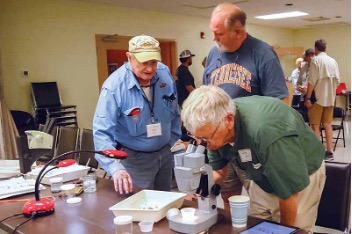
Clayton Gist, Dennis Baxter and Larry Ward, members of the Clinch River Chapter of Trout Unlimited, look at samples of insect river life through a microscope.
Under the Microscope
Outside the Norris Community Center in east Tennessee, a fine drizzle slicked pitch-dark streets.
Inside, Matthews and Stephan presented vial after vial of insect life from different river sites.
“OK, here’s something really cool,” Matthews said.
He prodded the sample – another caddisfly larva in a coffin-like case – until tiny pebbles attached to the sides came into focus.
“They always have two ballast stones, one on either side … to help hold that case down,” he said.
He explained that most caddisfly larvae build cases – some of rock, some of wood – and attach themselves to large rocks in the stream. Others spin webs or crawl around free, but all catch tiny insects in the current.
“We found caddis rock cases tucked in the wood grain, too,” Bill Toth, the Clinch River chapter’s president, said as Matthews sifted through more samples.
More creatures appeared. Scuds – tiny humpbacked coils of freshwater shrimp – and cranefly larvae. Long horsehair worms like whips. Mayflies and aquatic snails.
Some creatures lived on rocks, others in the shallows – even in the moss and grass.
Each one gave these fly fishers a clue about what flies to tie and where to best cast a line.
For TVA scientists, the creatures together tell the story of river health. When not on display, they’re part of TVA’s collections, labeled with location and date information.
And, Matthews said, some specimens will go into a reference collection – like a library of river life – that chapter members can learn from and use for outreach.
“This lab is something else,” Stephan said. “There’s a closet with shelves all the way up … just jars and jars.”
Beyond biological data at the lab, the River Forecast Center gives vital flow information for fly fishers.
“You realize how small a part of the system we are,” Stephan said, recalling a past visit to the River Forecast Center. “Everything that goes into making the water pass through the dam … (and) how much passes through. There are people there on 12-hour shifts, and there’s somebody that’s looking at a monitor 24/7.”
“We get into a flood situation, they don’t go home,” Matthews agreed. He suggested a future Trout Unlimited tour. “I never get tired of listening to those engineers talk about managing competing demands on our system of dams and rivers.”
Corn Flies and Tiny Size
The interconnected, ever-flowing rivers themselves call to fly fishers.
But just as appealing for many in this crowd is the lead-up – the research, the fly tying, the watching and wading that precedes a good day of casting into the misty morning water.
Matthews and Stephan invited attendees to the front to see creatures up close, and that’s when the stories started to fly.
Larry Ward said he relished tying flies to “match the hatch” of aquatic insects.
“Imagine,” he said, looking up from a mayfly larva under the microscope. “They’re in different stages of their life as the summer goes on. Sometimes they’re on the bottom and they look one way, and sometimes they’re on the top and look different.”
Ward created his own favorite fly years ago.
“I had one invented up here called the Clinch Bug,” he said, smiling. “When I first came here, they used pink marshmallows and corn (as bait). So, I made a corn fly. It actually worked pretty well.”
He chuckled. “Most of the time we used the midges, which are these chironomids (Matthews) is talking about or worms like that little one right there. But the flies we use are a lot smaller than that.”
He’s not the only tier of tiny flies.
Clayton Gist, who “fished before he could feed himself,” now teaches others in the Clinch River chapter how to tie size 26 flies.
Higher numbers mean smaller flies, like those tiny midges. The smallest in the world is 32.
“It’s just amazing,” Dennis Baxter, retired TVA biologist and Trout Unlimited board member, said of Gist’s skill. “I can get to (a size) 22.”
“(A 26) is about the size of a comma on the page,” Gist explained, pinching his fingers almost shut.
“I tried,” Baxter sighed. “Basically, it’s the shaft of a peacock herl without the fluff. And you split it in half, soak it in water and … wrap it around … (and) put a little white tuft on the top.”
Gist leaned in conspiratorially.
“The secret about tying real small flies is all your mistakes are real small, too,” he whispered.
“I’m trying to get it perfect,” Baxter said with a smile. “But the fish don’t care.”
Photo Gallery
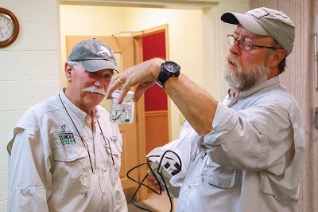
Bob Stephan, Clinch River Chapter of Trout Unlimited president, and TVA aquatic zoologist Dave Matthews talk about an aquatic macroinvertebrate sample at the end of the Clinch River Chapter of Trout Unlimited meeting.

Aquatic insects and larvae – benthic macroinvertebrates – loom large on a projected screen. Their presence can give clues about water quality.
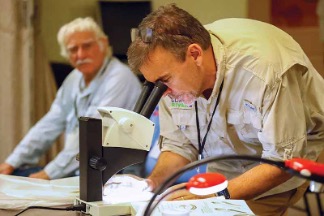
Bill Toth, who’s on the Clinch River Chapter of Trout Unlimited board of directors, looks through a microscope at an aquatic creature that calls the Clinch home.

